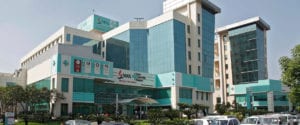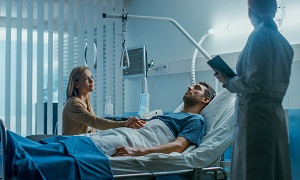Best Brachytherapy Doctors & Hospitals in India
- Radiation Oncologist, Chennai, India
- Over 30 years’ experience
Profile Highlights:
- Dr. Sanjay Chandrasekar serves as a Radiation Oncology consultant at Apollo Hospital of Chennai. His 30+ years-long journey in this field has brought him a lot of appreciation and recognition.
- He diagnoses cancer and provides treatment for the same.
- Radiation Oncologist, Chennai, India
- Over 32 years’ experience
Profile Highlights:
- Dr. Rajendran B has developed expertise in the treatment of conditions like Cancer and Central Nervous System Tumors.
- He has studied radiotherapy and was recognized as the first oncologist to perform radiosurgery in Northern Malaysia in 2008.
- Dr. Rajendran takes interest in engaging in social groups related to his field and holds Indian Medical Association (IMA) membership.
Best Brachytherapy Hospitals India
Fortis Memorial Research Institute, Gurugram
- City: Gurugram, India
Hospital Highlights:
- Fortis Memorial Research Institute is a multi-super-specialty, quaternary care hospital with 1000 beds. The hospital comprises reputed clinicians, and international faculty and is also equipped with cutting-edge technology. The hospital is a part of Fortis Healthcare Limited, a reputed chain of private hospitals in India.
- It is a NABH-accredited hospital that is spread across 11 acres of land and has a capacity of 1000 beds. The hospital has 55 specialties and is one of the premier health care centers in the Asia Pacific region popularly known as “the Mecca of Healthcare”.
- The hospital has 260 diagnostic centers and is also equipped with the latest and advanced techniques that include 3 Telsa which is the world’s first Digital MRI technology. The hospital also has world-class Radiation Therapy techniques which have been developed by leading technology experts from Elekta and Brain Lab.
Gleneagles Global Hospital, Parel, Mumbai
- City: Mumbai, India
Hospital Highlights:
- Gleneagles Global Hospital The 450-bed facility comprises of 17-stories, housing state-of-the-art infrastructure, and advanced medical care facilities.
- The hospital offers end-to-end clinical, surgical, and diagnostic services. It is equipped with a team of eminent medical professionals aided by qualified nurses and medical staff
- The Hospital offers advanced Endoscopic procedures, Hepatobiliary and Liver Surgeries, Surgical and Medical Gastroenterology, Bariatric Surgery, and Robotic surgery.
- The hospital is a center of excellence for Orthopedics, Joint Replacement, Knee Replacement, and Hip Replacement surgery.
Gleneagles Global Hospitals, Chennai
- City: Chennai, India
Hospital Highlights:
- Established in 1999, Gleneagles Global Hospital, Chennai, is one of the top healthcare facilities in Southern India. It is part of the Gleneagles Hospital Chain, which is the fourth largest healthcare chain in the country. The hospital specializes in multi-organ transplants of kidneys, liver, lungs, heart, etc.
- The hospital has an excellent infrastructure and state-of-the-art lab and equipment set-up. The hospital boasts cutting-edge technologies, a highly skilled team of doctors and surgeons, and trained support staff. Located in Perumbakam, Chennai, it is one of India’s premier health care destinations. The hospital has performed some of the most complex surgical and clinical procedures in India including multi-organ transplantations.
- The hospital’s lung transplantation program is one of the best in the country. The hospital is known for having performed India’s first single lung transplant and first minimal invasive lung transplant. It is also the only Indian hospital to be associated with King’s College Hospital, London, United Kingdom for liver transplantations.
Indraprastha Apollo Hospital, New Delhi
- City: New Delhi, India
Hospital Highlights:
- Indraprastha Apollo Hospital is a 700-bedded multispecialty hospital in the heart of the capital of India. It is a part of Apollo Hospital group, one of India’s most reputed healthcare chains. Indraprastha Apollo Hospital has been accredited by Joint Commission International, making it the first internationally accredited hospital in the country in 2005.
- There are 52 specialties in the hospital with one of the best cardiology centers in the country. The hospital is also equipped with State of the art infrastructure facilities with the largest Sleep Lab in Asia and the largest number of ICU bed facilities in India.
- The hospital also has one of the largest dialysis units in India along with a dedicated Bone Marrow Transplant unit.
- The latest and highly advanced technologies that are installed in the hospital include Da Vinci Robotic Surgery System, PET-MR, PET-CT, Cobalt-based HDR Brachytherapy, Brain Lab Navigation System, Tilting MRI, Portable CT scanner, 3 Tesla MRI, 128 Slice CT scanner, DSA Lab, Endosonography, Hyperbaric Chamber and Fibro scan.
Jaypee Hospital, Noida
- City: Noida, India
Hospital Highlights:
- Jaypee Hospital is the flagship hospital of the Jaypee Group.
- This hospital has commissioned 525 beds in the first phase and has been planned and designed as a 1200 bedded multi-specialty facility.
- It holds the accreditation of the NABH and NABL.
- The hospital has state-of-the-art infrastructure equipped with the latest technologies and modern equipment like 64 Slice PET CT, Dual Head 6 Slice SPECT CT, Gamma Camera, and Da Vinci Robotic Surgery for comprehensive robotic surgical solutions.
- It has special Centers dedicated to the major specialties to provide hassle-free and high-quality clinical care.
KIMS Hospital, Hyderabad
- City: Hyderabad, India
Hospital Highlights:
- KIMS Hospital (a brand name of Krishna Institute of Medical Sciences) is one of the largest and best multi-speciality hospitals in Hyderabad. The hospital provides various treatments to an enormous number of patients.
- The hospital has a capacity of more than 3000 beds. KIMS Hospitals offers different healthcare services in more than 25 specialities and super specialities.
- The hospital is equipped with modern medical equipment and technology. It has robotic equipment to provide minimal invasive techniques for patients.
- The hospital is aimed at providing world-class healthcare facilities and services at an affordable cost for patients.
- The various specialities and departments of the hospital include neurosciences, gastroenterology & hepatology, robotic science, reproductive sciences, dental science, oncological sciences, organ transplantation, heart and lung transplantation and mother and child care.
Kokilaben Dhirubhai Ambani Hospital, Mumbai
- City: Mumbai, India
Hospital Highlights:
- Kokilaben Dhirubhai Ambani Hospital, Named after the wife of Indian industrialist Dhirubhai Ambani, the founder of Reliance Industries, this is one of the top hospitals in Mumbai. This 750-bed multi-specialty hospital became operational in 2009. Known as one of India’s most advanced tertiary care facilities, the hospital is designed to raise India’s global standing as a healthcare hub, with an emphasis on excellence in clinical services.
- Kokilaben Dhirubhai Ambani Hospital uses Protocol and Care Pathway based treatment models to ensure the best outcomes for patients.
- The hospital represents a confluence of top-notch talent, cutting-edge technology, state-of-the-art infrastructure, and, most importantly commitment.
- The hospital also holds the accreditation of the NABH, NABL, CAP, and JCI.
- The hospital has been recognized as the No. 1 Multispecialty Hospital in Mumbai and the West Zone for the fifth year in a row in 2020 by The Week.
Lilavati Hospital & Research Centre, Mumbai
- City: Mumbai, India
Hospital Highlights:
- Lilavati Hospital & Research Centre is India’s premier multi-speciality tertiary care hospital and has been recognised as a global medical excellence centre.
- Lilavati Hospital & Research Centre has built an unrivalled level of trust with its patients over the years, thanks to a solid foundation that comprises cutting-edge facilities, the best medical competence, research, education, and charity endeavours.
- The hospital is quite proud of the fact that it now serves patients from all kinds of backgrounds, not just from the United States but from all around the world.
- The hospital has a total of 323 beds, one of the largest Intensive Care Units (ICUs), 12 Operation Theatres with modern amenities, over 300 consultants, and almost 1,800 personnel.
Manipal Hospital, Dwarka, Delhi
- City: New Delhi, India
Hospital Highlights:
- Manipal Hospitals, Dwarka, is a super-specialty hospital in Dwarka, New Delhi, which is a part of Manipal Hospitals Group.
- The hospital aims to provide the best treatment on par with international standards at a fraction of the cost.
- Equipped with 380 beds, the hospital is also one of the new age hospitals which are equipped fully with state-of-the-art infrastructure, cutting-edge technology as well as the latest and advanced clinical practices. The hospital also has 13 modular Operation theatres with 118 beds which are solely meant for critical care.
- The hospital comprises internationally acclaimed doctors and highly professional and experienced hospital and medical staff who are able to provide preventive, therapeutic, and diagnostic services all under one roof.
Max Super Specialty Hospital, New Delhi
- City: New Delhi, India
Hospital Highlights:
- One of the well-regarded providers in India committed to the highest standards of clinical excellence and patient care, Max Super Specialty Hospital is a part of Max Healthcare, which is the second-largest healthcare chain in India. Regarded as one of the most well-regarded healthcare providers in the country, Max Super Specialty Hospital is committed to the highest standards of clinical excellence as well as patient care. The hospital is also equipped with the latest technology as well as cutting-edge research. The hospital is known to deliver and ensure the highest level of patient care.
- The hospital has more than 500 beds and offers treatment for over 35 specialties. The hospital also holds the credit of having installed the first Brain Suite in Asia. This is a highly advanced Neurosurgical machine that allows MRI to be taken while surgery is ongoing.
- Other advanced and latest technologies are also installed in the hospital such as the 1.5 Tesla MRI machine, 64 Slice CT Angiography, 4D ECHO, LINAC, and 3.5T MRI machine.
Brachytherapy
Gone are the days when Cancer Treatment only meant chemo or external radiation therapy. Thanks to the medical science advancement, cancer treatment methods have undergone some recent changes with new, more focused treatment methods cropping up on the scene! Brachytherapy is one such treatment method that focuses on cancer tumors by placing small radioactive implants as close to the tumor location as possible.
One of the primary reasons why Brachytherapy is recommended, because this therapy focuses on high doses over a small space with the radiation concentrating on the tumor and not on the surrounding tissues or cells. This prevents damage or harm to the surrounding areas of the tumor.
Now you must be wondering how Brachytherapy works with such precision and we’ll get to that, but before we do, let’s breakdown the basics of this treatment style starting with the question-
What is Brachytherapy?
In its simple form, Brachytherapy can be defined as a type of internal radiation in which an implant, which can be anything from wires or seeds to capsules, with a radiation source in it is directly placed inside the body, closer to the tumor. Also known as Internal Radiation Therapy, this form of therapy can effectively shrink the tumor size if not downright eliminate it from your system and can be used to treat cancer types such as-
- Lungs
- Breast
- Prostate
- Head & neck
- Eye
- Uterus, etc.
What are the Different Brachytherapy types?
Primarily, there are two types of Brachytherapy:
Low Dose Rate (LDR) Brachytherapy
- Low Dose Brachytherapy also known as permanent brachytherapy, is a continuous treatment process where a radioactive implant is permanently inserted (either manually or through a machine) in your body and a low dose of radiation seeps out of it continuously for weeks, maybe months, depending on the intensity or growth rate of the tumor. The radioactive implant will release a particular dose of radiation and would focus on gradually shrinking or weakening the tumor.
- In this procedure, you may be asked to detain yourself in the hospital due to the presence of radiation within your body. Even though it’s not harmful, you’ll be kept in a private room with limited visitor access (no children or pregnant women).
- The insertion of the brachytherapy device will not be painful since in most cases anesthesia is used to reduce discomfort. In fact, the presence of the radioactive implant in your body shouldn’t cause any pain or discomfort and if it does, notify your medical team immediately.
High Dose Rate (HDR) Brachytherapy
- High Dose Brachytherapy also known as temporary brachytherapy, is more of a session-wise treatment procedure where radioactive implants are temporarily placed within the body and the therapy continues for a few minutes, up to half an hour itself. Post this, the temporary radiation tube is removed and you can return back to your normal lifestyle without any hassle.
- Since HDR Brachytherapy session is brief, these are recommended for outpatients only which means you don’t have to stay back in the hospital or in isolation. Your medical team may recommend up to 2 sessions of a few minutes each in a day and once the tube is removed, you are free to go. You will also not be radioactive which means you can meet people after your session.
- During the HDR procedure, the radioactive material will be inserted using a computerized machine. Your medical team will leave you alone in the room to avoid unwanted exposure but they will closely monitor you from a nearby room. You can notify them if you feel discomfort or pain, but in most cases, the patients don’t. Once the procedure is done, your medical team will come back in, remove the radiation device and you’ll be free to move about.
Who will your medical team consist of?
Much like any other cancer cure team, there will be some core professionals consisting of radiation oncologists, radiation therapists, dosimetrist to measure your dose, a general physicist on standby (for health ailments occurring during the procedure). There will also be a support team of anesthesiologists, surgeons (to insert or extract implants) and nurses for general care during and after the procedure.
How do you prepare for your brachytherapy?
Once diagnosed and determined, your medical team will decide if Brachytherapy is a suitable option for your condition. Once determined, you will be asked to share a detailed report of your medical history including ongoing medications, health supplements, etc. Consult with your healthcare team for dietary regulations and if any is necessary or not! Your doctor may prescribe certain clinical tests to understand your condition better which can be in the form of :
- EKG
- MRI/ CT scan / Ultrasound
- Certain blood tests
- Chest X-Ray or other imaging tests
- Bowel preparation
What to expect during the Brachytherapy procedure?
Now let us give you a step by step breakdown of what you might expect during this procedure!
Pre-procedure
You’ll have a brief meeting with your medical team before the Brachytherapy procedure during which your doctor/nurse will go over some preliminary exams which may include imaging tests, physical exams, discussing the procedure including side-effects and so on. During this period, patients are requested to share an in-depth report of their medical histories which should also include ongoing medication, intake of health supplements or blood thinners such as aspirin and more. You can even discuss post-procedure care along with dietary regulations or preventative measures.
During the procedure
So by now, you’re aware that Brachytherapy requires focused radiation to eliminate cancer cells, but are you aware of where the implants are placed? Even though the aim is to place the implants as close to the tumor as possible, there are a lot of variables that need to be taken into account. For instance, there are 3 primary locations that are frequently used and they can be:
- Intracavitary Treatment- In this method, the implant is inserted inside cavities within the body, such as uterus or breasts
- Interstitial Treatment- In this method, the implant is inserted right inside the tumor mass.
- Internal Radiation Therapy- In this method, the radiation is inserted in the form of a medicine, preferably through a vein or into a body cavity.
Depending on the procedure type you may have to stay back in the hospital for a few nights or be in an isolated room while your temporary radiation procedure takes place. You can refer to our Different Brachytherapy Types segment to know more about this.
Post-procedure radiation management & brachytherapy
There is always a chance that the radiation source in your body may make you radioactive for a brief span of time which is why patients are often requested to stay indoors, preferably isolated for a while. This is more common in high-dose brachytherapy where the radiation source is implanted inside the body.
This also means visitors with chronic illnesses, children and pregnant women should avoid coming in contact with you. In fact, visitor meet and greet should be kept zero or at the minimum to avoid unnecessary exposure.
FAQs
1. What are some of the Brachytherapy side effects I should be aware of?
Both LDR and HDR may come with certain side-effects. The most immediate ones that occur right after the procedure can be urinary problems including blood in the urine or frequent need to pass urine. Some later symptoms may include constipation.
2. How long will the implant stay in my body?
This solely depends on your cancer cure rate. Depending on the severity of the condition or your body’s reaction to this procedure, the implants may stay for weeks and even months. However, once the radiation oozes out of the implants, they won’t stay active anymore.
3. How would doctors know if the procedure is working or not?
4. Will I feel pain and discomfort during this procedure?
Even though the implant plantation itself can be a little painful (which is why doctors use anesthesia for this part), once the implant is inside, you shouldn’t feel any pain or discomfort.















